Sharlyn J. Lauby's Blog, page 105
January 11, 2019
Staffing and Scheduling are Two Different Things – Friday Distraction
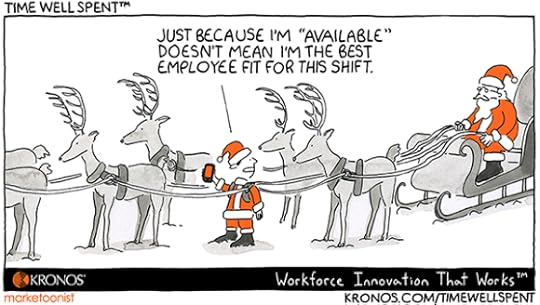
I know that Christmas was last month, but I can’t resist sharing this Time Well Spent from our friends at Kronos because it beautifully demonstrates that staffing and scheduling are two different things. Staffing is about finding the right people to do the work. And scheduling is about making sure they show up at the right times. Both are important.
I remember working on a project years ago where the company was convinced that their problem was staffing. They kept telling everyone that they didn’t have the right people. And that they weren’t being trained properly. After a thorough analysis, the problem was discovered to be scheduling. Oh sure, the company could have used a few more good employees and some better training. But the bottom-line was that employees weren’t being scheduled when the operation needed them the most.
Identify key tasks that must be completed during operational shifts. Think about what needs to happen during each shift in your organization. I’m reminded of my hotel days when we created opening checklists or closing checklists. It was a reminder for everyone in the department what needed to happen.
Spread the work around. Speaking of those checklists, one person didn’t complete the entire checklist. One employee might do 1-2 items. Another employee was responsible for 2-3 items. This approach created more of a team environment where each employee was a contributor to the department’s success.
Encourage cross-training so there are multiple employees who are capable of doing these tasks. Finally, because multiple employees were involved in the opening / closing checklist, the department didn’t miss a beat when an employee called in sick or took vacation. Another employee simply filled in.
As the labor market continues to challenge us, this will be a real issue for companies. If you have one employee who completes a specific report every week, what is the company going to do if that person resigns tomorrow? While the company can simply dump the work on another employee’s desk, that doesn’t mean they’re the best person for the job. Sorta like giving a reindeer’s job to an elf, if ya know what I mean…
Part of running a smooth operation is making sure that the right people are working at the right times. It’s also making sure that “back-ups” are in place so those “right people” can take a day off, go to an all-day workshop, or deal with an emergency. They can focus on what they’re doing while at the same time, the company can focus on running the business.
The post Staffing and Scheduling are Two Different Things – Friday Distraction appeared first on hr bartender.






January 10, 2019
Peer to Peer Learning: Why It Should Be Part of Your Training Strategy
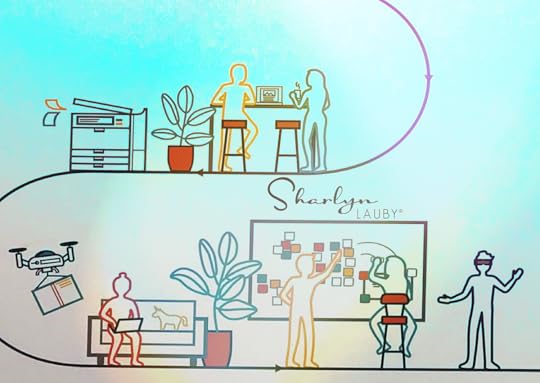
Co-workers play a huge role in the employee experience. An increasing number of organizations include peers in the hiring process so candidates can meet some of their co-workers. Companies are adopting new hire buddy programs as part of the welcoming and socialization process during onboarding. Multi-rater reviews (sometimes called 360-degree feedback) ask for feedback from peers as part of the process.
Another aspect of the employee experience that we don’t talk about much is peer to peer learning. Peer based learning can take place in both a formal or informal organizational setting. What’s great about peer to peer learning is that both the sender and the receiver can find the experience valuable.
I recently sat down with a friend and colleague of mine, Kathy Shurte, CPLP, CPM, district organizational development manager for the Florida Department of Transportation, to talk about peer to peer learning programs and the value they bring to employees and organizations. I’m thrilled that Kathy agreed to share her expertise with us.
Kathy, I’d like to think that everyone understands the value of peer-based learning, but as an in-house learning and development (L&D) professional, what’s your take?
[Shurte] As an L&D professional, my take on peer-based learning is that, while it is not a new idea, it certainly is an idea whose time has come! I know I provide a valuable service to my organization, and historically that value has been through training opportunities I’ve created, facilitated, provided, or recommended. That has all been good, and there is still a definite need for structured learning events.
But when I think back over my own life, there is no denying some of my most important lessons happened with a friend by my side, patiently showing me how to balance on ice skates or how to roast a chicken. Sometimes there was more laughter than patience, but a friend in need was still a friend. In the workplace, there was always someone who knew the job better than I did and was willing to let me learn from his or her mistakes. Getting me up to speed quickly was a win-win situation!

Fast-forward several decades and we live in a different time. The world has shrunk, we communicate differently, and the resources that are available to us are simply mind-blowing. ‘Change’ has become my new definition for life. How does one take it all in and learn to make sense of it? Peer to peer learning. No one has a training staff large enough to allow them to create a structured learning opportunity for every new app, idea, or thing that appears on the horizon with each day’s rising sun. But there is always someone, somewhere, who can grasp it and pass it on.
Now our role as an L&D professional must expand to embrace the fact that our ‘training team’ is everyone. We’ll have to look for trends, figure out how to ensure the information shared is accurate (or something that we want to be shared), understand how to quantify it, and know when to pick it up and add some structure to it. Peer-based learning is not going to go away; we need to embrace it and support it.
In your experience, what types of peer to peer learning programs can organizations implement with very few resources?
[Shurte] An organization can implement different peer to peer learning programs with very few resources. Our organizations are quickly filling up with young people who are tech-savvy and collaboratively conscious. We have two generations that have grown up wanting to share everything they do, have or know, and they use technology to share it with as broad an audience as possible (think global!). A smart organization will tap into that – and it takes very little to do so. Government organizations have more issues with technology and transparency, but private sector enterprises can allow employees to mingle personal devices and company resources to achieve amazing returns.
Setting up social media sites (or internal versions of the same) allows employees to ‘show off’ an idea or skill. Mentoring programs now match mentors with new hires, and never mind that the mentor has yet to finish his or her probationary period. Of course, mentors with more tenure work well too. Setting up ‘sandboxes’ or ‘playgrounds’ where employees can explore applications provides a safe learning environment where failures are less painful. Creating ad hoc teams to address problems spurs innovation.
You’ve mentioned technology already, so let’s explore that more. Where can technology provide value in peer to peer learning?
[Shurte] It makes me sound old to say this, but kids today are wired differently! I’ve seen children just barely a year old pick up a smart phone and, not only find the games, but play them, too. Technology is like an added appendage. Who hasn’t at one time or another wished for an extra arm or two? Technology affords its gifted users an added advantage relative to communication, learning, researching and/or sharing information. It can hardly be separated from the person.
A caution, though, just as any strength becomes a weakness when it is over-used, we have a generation that struggles with interpersonal skills, and a peer cannot share what a peer cannot do. So as L&D professionals, we all need to be on the lookout for ways to help everyone maintain a swatch of humanity.
Do you see a downside to peer to peer learning? And is there a way for organizations to mitigate the risk?
[Shurte] The downside to peer to peer learning is that left unto itself, there may be quality issues. If I only think I do a great job, and then I show all my friends how something is done, they won’t be great at it either. Also, we still have people in our organizations, often older and often senior, who don’t recognize or value any kind of informal learning, be it peer to peer or stretch assignments. L&D has a role in educating that faction on all the ways learning can take place.
Organizations can mitigate the risk of poor quality by including segments of peer learning in staff meetings or wherever groups of employees meet formally. Managers can be present, watching from a distance and then giving feedback when they see peer to peer learning taking place. Recognize it, and specifically say what made it good. If there is a way to formalize peer to peer learning, using a learning management system (LMS), an internal certificate/certification program, or even simple corporate badges – these can all help mitigate quality issues.
Last question. With the increase in collaborative work, what do you see as the future of peer to peer learning?
[Shurte] I see the future of peer to peer learning as another tool in my toolbox, something that is here to stay, something that I need to embrace and coach. If indeed any of us is a lifelong learner, the natural outgrowth of that is to be a lifelong sharer and cultivator of peer-based learning.
A HUGE thanks to Kathy for sharing her knowledge and experience with us. As Kathy mentioned, peer to peer based learning isn’t going away anytime soon. Organizations are going to want to embrace this opportunity. We hire super smart people to work at our companies. Why wouldn’t we create an organizational culture where they feel confident and comfortable sharing their knowledge with others? Everyone benefits.
Image captured by Sharlyn Lauby while exploring the streets of New York, NY
The post Peer to Peer Learning: Why It Should Be Part of Your Training Strategy appeared first on hr bartender.






January 8, 2019
Employee Burnout: 5 Organizational Programs That Can Reduce It

(Editor’s Note: Today’s post is brought to you by Concordia University, St. Paul (CSP). Become a more effective HR professional with an with an online Bachelors in HR or an online Masters in HR. CSP offers small class sizes with a personal learning environment geared toward your success and knowledgeable faculty who have industry experience. Enjoy the post!)
Nearly half of HR leaders say that employee burnout is responsible for up to 50 percent of the company’s turnover, according to a survey from Kronos Incorporated. In addition, ninety-five percent (95%) say employee burnout is sabotaging workforce retention. Think about that for a moment, not only is burnout a cause of turnover, but it’s an obstacle to retention. We know what that means. The area between retention and turnover is disengagement.
“Employee burnout has reached epidemic proportions,” said Charlie DeWitt, vice president of business development at Kronos. “While many organizations take steps to manage employee fatigue, there are far fewer efforts to proactively manage burnout. Not only can employee burnout sap productivity and fuel absenteeism but, as this survey shows, it will undermine engagement and cause an organization’s top performers to leave the business altogether. This creates a never-ending cycle of disruption.”
Unfortunately, there may not be a simple solution to employee burnout, but many factors contributing to it are within the organization’s control.
What is Employee Burnout?
According to World Psychiatry, employee burnout is a prolonged response to chronic emotional and interpersonal stressors on the job. The response has three key dimensions: overwhelming exhaustion,feelings of cynicism and detachment from the job, andasense of ineffectiveness and lack of accomplishment.
It’s important to realize that employee burnout is not typically the result of a single factor, such as working too many hours or having a demanding boss. Employee burnout has complex causes, which is why it’s so costly to individuals and organizations.
The Five Domains of Employee Burnout
There are several organizational risk factors for employee burnout, but five domains have been identified by researchers:
Values are the ideals and motivations that originally attracted employees to the job. They motivate workers beyond money or advancement. A conflict between individual and organizational values forces a trade-off between work employees want to do and work they have to do.Work overload is (obviously) having too much work. When employees have work overload, it weakens the employee’s ability to meet performance goals and leaves little opportunity to rest and recover.Control and community become a factor when employees feel they don’t have an influence on decisions that impact them, their work, or their career. And that they don’t feel anyone cares. Employees aren’t looking for absolute control. They understand there’s an organizational hierarchy. But they do want to feel that they have a trusting community of supporters.Rewards and recognition show employees that they and their work are valued by the organization. The rewards and recognition can be financial, institutional, social, or a combinationof all three. While rewards and recognition are always important, they are especially so when employees have a lot of work to complete (See #2).Fairness refers to work decisions being perceived as fair and equitable. Employees tend to gauge their value on the quality of procedures and their own treatment during the decision-making progress. Not being respected can lead to cynicism, anger, and hostility.
Employee Burnout: The (Negative) Business Outcomes
Employee burnout can negatively impact workers and organizations in three areas: employees, teams, and organizations.
Employee burnout contributes to poor health. Physical exhaustion is the most predictive variable of stress-related health outcomes and is linked to symptoms like headaches, chronic fatigue, gastrointestinal disorders, muscle tension, hypertension, cold/flu episodes, and sleep disturbances.
Team dynamics are impacted when employees experience burnout. It is perpetuated through social interactions, personal conflict, work disruptions. Burnout causes negativity in working relationships.
For organizations, employee burnout is linked to job dissatisfaction, low employee loyalty, absenteeism, disengagement, and turnover. Burnout makes it more likely for workers to leave the company, and those who stay tend to have impaired quality of work and lower productivity.
5 Employee Programs That Can Help Reduce Burnout
To reduce burnout, organizations can implement programs that are directed at the major causes. According to human resources consulting firm Robert Half, here are five ways to enhance retention that could also assist in reducing employee burnout.
Employee Compensation: In the Kronos survey, forty-one percent of respondents said that unfair compensation was the leading cause of employee burnout. Organizations can distinguish themselves in the job market and address burnout by offering competitive compensation and benefits packages.Training and Development: Professional development programs can help employees improve their skills, which benefits employees and organizations alike. It not only helps employees manage challenges but it’s a strong way to hire from within.Recognition and Rewards Systems: Organizations can demonstrate appreciation through a heartfelt email message, a gift card, or an extra day off. A small budget shouldn’t discourage managers from recognizing hard work.Work-life Balance: Flexible scheduling allows employees to arrive at work later than normal for personal reasons or following a late night of work. Another way to enhance work-life balance is with telecommuting. One study in Harvard Business Review found that remote workers were happier, less likely to quit, and more productive than their in-office peers.Mentorship Programs: More experienced employees can mentor colleagues to provide them with the guidance and resources they need. By using peers instead of work supervisors, employees can receive help in a less intimidating environment.
Make an Investment in Reducing Employee Burnout
Employee burnout is a multidimensional response to several risk factors. However, the complicated nature of employee burnout is not the reason it has become one of management’s biggest challenges. According to the Kronos survey, the reason that burnout is a major organizational issue is because organizations are not focused on enhancing retention. Approximately one in six survey respondents said that funding is the biggest obstacle in improving employee retention and engagement.

Which is surprising, because turnover in organizations is costly. Research from the Society for Human Resource Management (SHRM) suggests that direct replacement costs can reach up to 60 percent of an employee’s annual salary, with total costs ranging to as much as from 200 percent of annual salary. Given the link between employee burnout and turnover, it’s time for organizations to invest in the employee experience and create programs that will help thrive.
The post Employee Burnout: 5 Organizational Programs That Can Reduce It appeared first on hr bartender.






January 6, 2019
Connect and Engage with Job Candidates Using These 5 Recruiting Strategies

Organizations spend hours sourcing applicants, reviewing qualifications, interviewing candidates, and internal discussions among the recruiting team. But one of the most important steps in the recruiting process is one some companies spend very little time doing – selection. When it comes time to evaluate and select a candidate, some hiring managers will spend minutes making a final decision on who to extend an offer to.
It only seems logical that candidates accept job offers from organizations they’re excited to work for. The question becomes, how do organizations create that excitement? The answer is by connecting and engaging with the candidate. Find ways to learn more about the candidate and vice versa. Connecting and engaging might seem like the same thing, but they’re not. Connecting means providing a way for communication to happen. Engaging is starting the dialogue.
It’s an important distinction because the way a candidate interacts with you during the interview process can help you evaluate how they will behave as an employee. For instance, if a candidate shows up for an interview and treats the company receptionist badly, what are the chances that they will treat customers badly? The good news is that in today’s technology driven business environment, we can connect and engage with candidates before ever interviewing them.
5 Recruiting Strategies for Connecting and Engaging with Candidates
Connecting and engaging with candidates isn’t a one-way activity. Remember that candidates are doing their own types of connecting and engaging activities to learn more about the organization. Here are five recruiting strategies to consider:
Create a robust employee referral program. Current employees are “connectors”, meaning they can introduce a candidate and the company. The organization benefits from the recommendation from a current employee, who knows what it’s like to work there. Meanwhile, candidates can learn the inside scoop about the organization from those same employees. This recruiting tactic continues to provide the highest quality of hire at the best cost per hire.Develop a talent network. According to a CareerBuilder’s Candidate Behavior Study, sixty-four percent (64%) of candidates research a company before applying to a job posting. This doesn’t mean that a candidate will never apply, but instead companies need to realize that the decision for a candidate to apply could take some time. Building a talent network, a place where candidates can virtually ‘hang out’ before they’re ready to apply is a great way to promote their employment brand as well as engage.Maintain a social media presence. Speaking of promotion, some of a company’s social media interactions can happen via their talent network. The goal is to be where your candidates are. Organizations want to understand how candidates find out about them and their openings. The desired result in connecting and engaging with candidates is getting them to apply. So, using social media to stay top of mind keeps the company visible with active and passive job seekers.Consider collaborative hiring. HR and hiring managers do not have to be the only people connecting and engaging with candidates. Collaborative hiring allows organizations to build recruiting teams, that include not only HR and the hiring manager but also include key employees that the candidate would regularly interact with. There are many benefits to this approach, especially during onboarding. Candidates can build relationships with more employees before day one. It also means that more employees have a vested interest in the candidate’s success. Use technology strategically. All of these activities point to the need for organizations to use their recruiting technology strategically. Today’s recruiting technology solutions allow companies to connect and engage with candidates before they apply as well as during the hiring process. In addition, companies can stay in touch with former employees and applicants, who can be a source for employee referrals and (possibly) become boomerangs.
Build Recruiting Strategies that Connect and Engage Candidates
To make the best hiring decisions, organizations need to take advantage of every opportunity they have to learn about the candidate, and not just their knowledge, skills, and abilities. Organizations want to know that a candidate is going to like the work and the company.
That’s why successful recruiting strategies involve connecting and engaging with candidates. Organizations can use their resources, including current employees and alumni, to build an effective recruiting community that will help them find the best talent. Because the greater the candidate engagement, the more likely they are to accept a job offer and become an engaged employee.
Image captured by Sharlyn Lauby while exploring the Wynwood Wall Art District in Miami, FL
The post Connect and Engage with Job Candidates Using These 5 Recruiting Strategies appeared first on hr bartender.






January 4, 2019
Give Employees Recognition and Rewards That Matter – Friday Distraction
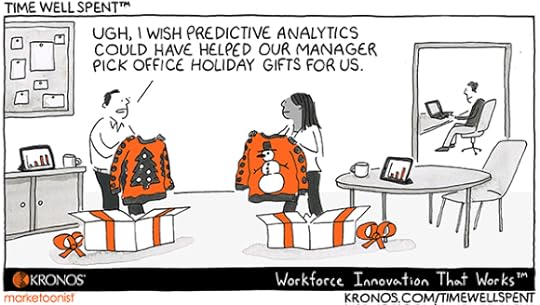
This Time Well Spent from our friends at Kronos ran shortly before the holidays, but I thought the message was an important one to share even after the New Year.
I’m sure 2019 is going to be a busy year. Every year seems to get busier than the last. Our calendars are full of meetings. We’re thinking about all of the goals we need to accomplish. Don’t get me wrong. I’m not complaining. The New Year can be exciting. But in all of the excitement, we can’t forget about recognition and rewards for employees and their hard work and efforts.
More importantly, we need to recognize and reward employees in a way that means something to them. Giving employees an “ugly sweater” is awesome if an employee wants an ugly sweater. Or lives someplace where they can use a sweater in general.
Find out what motivates employees. There are plenty of opportunities to ask employees what matters to them. You can ask during the interview. Or maybe create an activity during orientation where employees make a personal user guide that includes how they prefer to be recognized. Another option is to straight up ask them during a one-on-one meeting. Whatever method you choose, don’t make assumptions that every employee values the same things.
Step out of your comfort zone. When it comes to recognition and rewards, managers should not expect employees to conform to the manager’s style. Managers need to deliver recognition in a way that is meaningful to the employee. Some employees appreciate public recognition. Others are mortified by it. In addition, if you’re a manager that prefers staying out of the spotlight, you might need to step into it to properly recognize an employee.
Look for signs that the recognition or reward was valued. I will admit that sometimes employees say, “Oh boss, I just love this!” and the truth is they hate it. But the employee doesn’t want to hurt feelings. If you want to know if an employee values a gift – see if they use it. Or pay attention when they mention recognition. It could be a small indicator of something that an employee appreciates.
We spend a lot of time talking about employee engagement and the employee experience. Recognition and rewards are big parts of it. And we’re not talking about big, expensive items. It could be as simple as “thank you”. But that thank you needs to be sincere and delivered in a meaningful way. It goes without saying (but I’ll say it anyway) that employees aren’t going to engage with an organization where they’re not appreciated. Because they can go find a company that will.
The post Give Employees Recognition and Rewards That Matter – Friday Distraction appeared first on hr bartender.






January 3, 2019
Management and Leadership: Organizational Strategies for High Performance

Every organization is striving for high performance. I don’t know of a single organization that’s saying, “Our vision is to be mediocre. Let’s just do enough to get by.” Organizations want to be the best. To do that, they need high-performing employees.
But to have high performance, organizations need to think about their learning and development strategies. Here are a few popular HR Bartender posts from the year that focus on learning and creating high performance.
The Difference Between Goals, Objectives and Outcomes
The key to employee engagement is employees who feel their work is valued. Talent management links value to business outcomes via goals.
How to Create Learning Paths that Align with Company Goals
Learning paths allow employees to build knowledge or skills. We want them to align with company goals. These six steps help align learning paths to goals.
Employee Coaching Is a Form of Accountability
Employee coaching is not the same as discipline. That’s important because coaching is often perceived as negative. It’s a discussion for accountability.
4 Ways to Measure the Success of Your HR Programs
There is only one sure way to know if your HR programs are a success – measure the results. There may be many was to do that. Here’s a proven method.
Managers are key in the execution of the company’s learning and development strategies. Organizations need to not only make investments in employee learning but manager development as well. Here are some topics to consider when it comes to management development programs.
The 10 Basic Skills that Every Manager Should Have
There are skills that every employee should have. Managers need those too, plus a few others. These are the 10 basic skills every manager needs to have.
Managers Should Spend the Majority of Their Time Doing This
Managers have a lot to do. And that’s exactly why managers should spend most of their time doing this. It helps with goals, performance and learning.
4 Ways Managers Can Create the Work Conditions for High Performance
Employee engagement and high performance should go together. There are 4 ways managers can encourage engaged employees into high performance.
Organizational success (which includes the bottom-line) is a result of employee performance. It only makes good business sense to invest in programs that will help employees become high-performers. This includes developing managers to be excellent coaches, trainers, and leaders.
Image captured by Sharlyn Lauby after exploring the streets of Gainesville, FL
The post Management and Leadership: Organizational Strategies for High Performance appeared first on hr bartender.






December 28, 2018
Employee Engagement: Resources to Plan Your 2019 Strategy
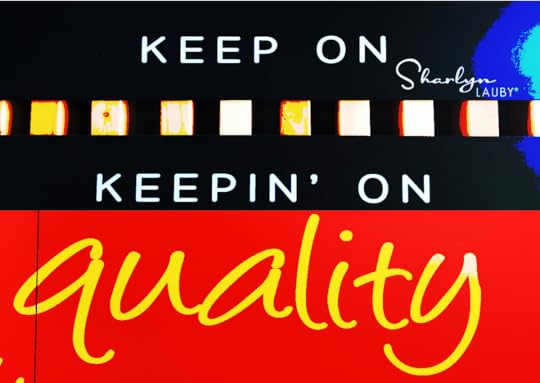
I don’t have to tell you that employee engagement will continue to be a hot topic in 2019. Finding the best talent is incredibly competitive. The last thing companies want is to spend their resources bringing in the best talent, only to have them never become engaged with the organization (and then leave). So, debating about engagement seems like a non-issue.
But being able to craft an engagement strategy is a challenge. How to sell the idea of creating a strategy, what to include, and how to measure results can be hard. So, I’ve put together a round-up of the most popular articles on HR Bartender that focus on building an engagement strategy.
Organizations Must View Employee Engagement as a Long-Term Business Activity
We know the business value of engagement. Organizations must view the employee experience long term, set realistic expectations, and focus on culture.
Employee Engagement and Commitment Are Not the Same Thing
Engagement is high priority today. It helps with retention and productivity. But we also want commitment from our employees. How do engagement and commitment differ?
Employee Engagement Is a Financial Strategy
The employee experience, engagement and satisfaction have value. Measurable financial value. And competition is driving that value to new heights.
How to Get to the Root Cause of Employee Engagement Issues
Action determines the success of your engagement surveys. Taking the right actions means understanding the specifics of employee feedback and what really matters.
Employee Engagement Surveys: 4 Planning and Execution Must-Haves
We know the value of the employee experience and using surveys to develop programs. Proper planning and execution are crucial in engagement surveys.
HOW TO: Turn Your Employee Engagement Survey Results into Action
Engagement surveys give employers a wealth of information. Here are three steps to turning engagement survey results into action.
Increase Employee Engagement and Retention with Better One-on-One Meetings
Communication helps managers drive employee engagement. One-on-one meetings are more important than ever to grow engagement and improve employee retention.
Employee Engagement Roadmap: It Is Not Too Late to Create Yours!
An engagement roadmap helps connect organizational actions with long-term goals and guides managers in activities that help build strong engagement.
These articles have examples and downloads that might help human resources departments guide their organizations through the exercise of creating an employee engagement strategy. I hope you find the information helpful.
Engagement has been around for decades. The value of a great employee experience isn’t going away anytime in the near future. People might try to find new names for it, but it’s still the same thing. The question is, what are organizations going to do about it. Because disengaged employees cost the organization hard dollars.
Image captured by Sharlyn Lauby at the 34th Street Graffiti Wall in Gainesville, FL
The post Employee Engagement: Resources to Plan Your 2019 Strategy appeared first on hr bartender.






December 20, 2018
How To Be More Creative In Your Career

I ran across an older white paper that talked about the importance of creativity. The article quoted a study from Adobe and Forrester that said 82 percent of companies believe there’s a connection between creativity and business results. I get it. Creativity is important.
I don’t know about you, but when I think of creativity, I think of artists like Prince or Picasso. I have to remind myself that creativity comes in many different forms. And for a logical thinker (like me), I can still be creative. But maybe I need a process to be creative. That’s okay.
Here are a few things I try to keep in mind when I’m trying to be creative – whether it’s to solve a problem, design a program, or just challenge myself.
Dedicate time to think. Former Secretary of State George Schultz was quoted in an article a few years ago about having a “Schultz Hour”, where he dedicated time on his calendar for the purpose of thinking. I love this idea and try to find time to do the same. One place where I get in “thinking” time is during air travel. Apply problem-solving skills. Everyone should find a problem-solving model that they love and can use regularly. It’s like finding your own system to get yourself “unstuck”. My model is called STP (Situation – Target – Proposal). Over the years, I find that it works for me. Think beyond the constraints. One of my personal ground rules for problem solving is “There are no rules.” I brainstorm the options and then evaluate all the details. I believe companies put a lot of constraints on themselves because they brainstorm options and evaluate them at the same time. They really should be two separate activities. Find what works for others and bounce ideas with respected coworkers. I know many people are best practice haters, but I’m not one of them. I think best practices can provide creative inspiration for ideas. The purpose isn’t to duplicate someone else’s best practice. It’s to use them as inspiration for your ideas. Experiment and take calculated risks. Everyone has their own level of tolerance for risk, so I wouldn’t encourage someone to take on more risk than they wish. But that being said, it is possible for us to experiment and explore. Instead of viewing options as “all in or nothing”, are there ways to test drive something and see if it makes sense? Take time to cool down. All the things I’ve mentioned involve a bit of stretching comfort zones. After we push ourselves, take a few moments to “cool off”. You know how, after a workout, we do a cool down? Do the same here. Declare a “no decision” time out. Of course, you can’t do this for a super long time, but find someway to clear your head and celebrate your creative time.
Maybe one of the ways we need to think of creativity is in terms of curiosity. I read an article in the December issue of TD magazine about curiosity. A survey cited in the article said the 83 percent of executives encourage curiosity and 49 percent feel curiosity leads to salary growth. So not only is this type of thinking good for the organization, but it’s good for us personally.
Creativity is a difficult subject. I see very few workshops or training programs about how to learn creativity. Most often, we hear about other people’s creative processes. And that’s okay. But we need to be able to take that information and turn it into some guiding principles that will help us be more creative.
What do you do to turn on your creative juices? Leave us a note in the comments.
Image captured by Sharlyn Lauby while exploring the Wynwood Wall Art District in Miami, FL
The post How To Be More Creative In Your Career appeared first on hr bartender.






December 16, 2018
Proven Retention Strategies to Help Reduce Employee Turnover

It’s no surprise that recruiting is a challenge. On some level, finding the right talent is always a challenge. So it’s logical that, once organizations find the right employees, they want them to stay. I mean no one says, “Hey, let’s hire Leonard. He’s not going to be very good and he’ll leave in a few months.”
The first thing that organizations need to realize is that employee retention is everyone’s responsibility. Turnover and retention are not “HR issues”. The factors that influence retention extend beyond human resources. The entire organization needs to buy-into making retention part of their role.
And if you’re wondering what those factors are that influence turnover, I did a survey here on HR Bartender about why employees leave companies. The common wisdom is that that employees leave bad managers. But the top reason may surprise you! Businesses need to be ready to address the issues. Here are a few popular posts from the blog that might help:
Reduce Turnover: Develop an Employee Experience Strategy
The employee experience drives turnover. Start with a great candidate experience and continue through the employee lifecycle.
What Employers Should Do When an Employee Resigns
When an employee resigns, employers should have a process in place to transition them properly. Here are some things to consider. Employees should be able to leave the organization with respect.
According to a survey from Korn Ferry, ninety-eight percent of senior leaders believe that structured onboarding programs are the key to employee retention. Making sure the company’s onboarding program is best-in-class only makes sense.
How to Assess Your Company’s Onboarding Program
Onboarding is more than just orientation. Done right, it helps retain and engage new hires. So, we need to assess our onboarding program for maximum effectiveness.
Companies Should Include Feedback Training in Onboarding
Feedback is an essential tool for maximizing employee engagement. So, include feedback training in your onboarding.
How to Evaluate the Success of Your Company’s Onboarding Program
Good onboarding is the key to new hire success. To evaluate the impact of your onboarding program, here are five effective data and feedback methods.
New Hire Onboarding: Take a Pulse to Increase Employee Retention
Employee retention is critical today. A pulse survey can help during onboarding to structure and receive effective feedback.
Organizations hire employees and want to retain them. But that means having the right processes and programs in place, so the employee is successful. It also means making employee success an organizational priority – not an HR program.
The post Proven Retention Strategies to Help Reduce Employee Turnover appeared first on hr bartender.






December 14, 2018
How to Manage Multiple Priorities – Friday Distraction
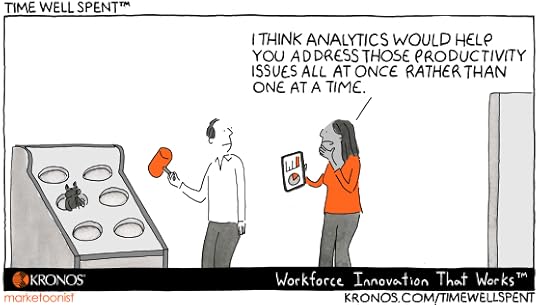
(Editor’s Note: Today’s post is brought to you by our friends at Kronos, a leading provider of workforce management and human capital management cloud solutions. Want to create an inspired workforce? Check out this Forbes interview with Kronos CEO Aron Ain where he talks about being an un-leader. Enjoy the article!)
There’s quite a bit of research that says multi-tasking isn’t good for us. And that we don’t really do it well. Even when we think that we do. But what does that mean in a world where we’re constantly being asked to manage multiple things…at the same time.
I don’t know about you, but somedays I feel like this Time Well Spent from our friends at Kronos. I feel like I’m playing Whack-A-Mole. And that’s not good. Over the years, I’ve figured out a few things that help me manage multiple things without feeling like I’m sacrificing quality – for both the project I’m working on AND my personal sanity.
Learn how to plan. I’m not talking about how to put appointments in your planner, although that can be helpful. I’m referring to finding time to think. Finding time to analyze information. Not just quickly glance at it and hastily make a decision. Having (the right) time to think, explore, develop crazy ideas and vet them can be immensely valuable.
Prioritize and reprioritize. New priorities are always popping up. The answer isn’t to simply add another priority. That’s a recipe for spreading ourselves way too thin. Whether you’re an organization or an individual, we need to decide if a new initiative is really a priority and where it falls on the list. Maybe it’s not priority number one. OR maybe it is, and we need to shift some other priorities.
Renegotiate commitments. I don’t’ want to say, “Don’t overcommit.” I think the better approach is, when faced with changing priorities, renegotiate your other commitments. Again, whether you’re an individual or an organization, go to the people you’ve promised a deliverable and discuss a new timetable. You’d be surprised how many people will be willing to work with you.
I don’t know that it’s realistic to think we’re never going to be asked to work on multiple projects or strategies at the same time. But that doesn’t mean we can’t reprioritize our commitments, so we can do our work well.
The post How to Manage Multiple Priorities – Friday Distraction appeared first on hr bartender.






Sharlyn J. Lauby's Blog
- Sharlyn J. Lauby's profile
- 10 followers



